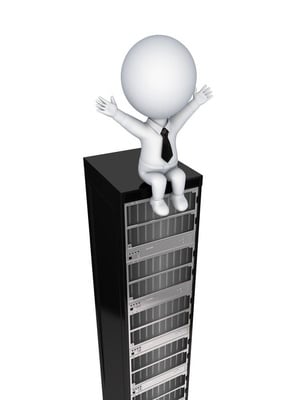
Thanks for returning for Part Four of Tech Service Today's technical buyer's guide series called Size Matters - Especially When Choosing A Network Rack in which we explain why IT professionals must evaluate every dimension of a cabinet or rack before purchasing one. Far too often product choices are made based on only one or two rack dimensions, and the repercussions of such carelessness can be costly.
In the first three segments we offered tips for calculating your real Internal Height requirements for a new rack or enclosure, emphasized the importance of comparing the height of your building's pathways to the External Height of a cabinet or rack, and explained that some manufacturers are still making racks with 23" and 24" rail widths to accommodate old telecom equipment, so you need verify your Internal Width requirements before making a final purchasing decision.
Today we will address the significant range of External Widths available on rack-mount enclosures (aka Cabinets), and provide valuable advice for determining which width will best meet your needs.
Part 4 - External WIDTH
When evaluating a new rack-mount enclosure to house network equipment and/or servers, it is important to understand why the external widths of cabinets range from 20" - 32" and wider. Even some seasoned IT professionals can not fathom why the external width of two cabinets can vary by up to 1-foot when, internally, they both contain the same, industry-standard 19" wide mounting rails.
When people ask me why anyone would need a 32" wide cabinet - meaning one with 6" of unused space between the side-panels and the mounting rails on both sides of a cabinet - my response is always "for SPACE". By SPACE, I am referring to a means to Secure Power And Cabling Efficiently.
When planning a new data center or even just a single-rack solution for an IDF or small office, it is a common oversight for IT managers to focus so much on their equipment and where it will be mounted in their rack, that they often forget about all of the network and power cables. This is the reason why so many racks look more like a chaotic cable jungle instead of the nice, neat racks the IT manager designed in Visio.
While cable management rings are frequently used on the front and rear rails of racks and cabinets to prevent cables from blocking access to the front and back of rack-mount equipment, in some high-density environments there are just too many cables to fit in those cable managers. Those are the environments where an extra-wide cabinet is the ideal solution because cables can be managed through larger side-channels where they will not interfere with or obstruct access to the vertical mounting rails.
So when you are shopping for a new rack-mount enclosure, the best way to determine the ideal External Width that will meet your needs is to consider the kind of equipment you will be mounting in the cabinet, and how many cables will be connecting to that equipment.
If your new cabinet will have very few cables because it will primarily house servers, then you should focus your rack-mount enclosures branded as Server Cabinets. Server Cabinets typically have exterior widths ranging from 23”-26” with the de facto standard being 24-inches because that is the size of the removable tiles used in the raised floors of many data centers.
If your new rack-mount enclosure will contain a lot of patch panels and switches, then a Server Cabinet not the right solution. Network Equipment Cabinets are wider enclosures, designed to accommodate high port-count equipment and the multitudes of cables connected to those devices. Equipment cabinets usually have exterior widths between 26”-32” (still with 19” mounting rails). This extra space between the vertical mounting rails and the side panels of Equipment Cabinets not only provides the room and side channels necessary for keeping the abundance of cables and cable managers from obstructing your access to the fronts and backs of your equipment, but also serves as a space for mounting vertical PDUs (power distribution units) - a solution that will free up some of the vertical mounting space on your rails for other equipment.
While all of the External Rack Width knowledge I have imparted on you is educational, today's Tech Tip explains how to actively incorporate it into your decision-making criteria when choosing your next new rack-mount enclosure.
Tech Tip #4 - External Width
Tips for determining the ideal External Width of a cabinet. First, make a list of all the equipment you want to mount in your new rack-mount enclosure, and include the total port counts of each. Since some devices feature redundant power supplies, list the number of power cables that will be connected to each device too.
If the equipment being mounted in the cabinet requires lots of cable connections, then lean toward a wider equipment cabinet. Conversely, if your cabinet will be primarily used to house servers, then a 24” wide server cabinet is recommended.
If you do not know whether or not all of your cables with fit in the vertical cable managers that you are considering using/mounting on the front and rear rails of your new cabinet, then use the cable diameter guide below to calculate the collective diameter of all your cables. Then compare the diameter of your cables to the diameter of the channel/rings in your cable manager to see if the cables will fit.
EXAMPLE: If your vertical cable manager has 3" rings or channels, then it will hold approximately 100 Cat5e cables.
| CABLE TYPE | DIAMETER |
| Category 5e | 0.28" |
| Category 6 | 0.32" |
| Category 6a | 0.34" |
Return tomorrow for our fourth segment in this series, focusing on the Internal Depth of rack-mount enclosures and the considerations of your internal depth requirements that must be weighed carefully before purchasing a cabinet.
Are you planning an IT rollout project involving the installation of new hardware and/or racks to multiple sites? Then download a free copy of TST's Best Practices for IT Rollout Projects.
5
Need help installing, troubleshooting, testing, documenting, or replacing your network cabling? Call Tech Service Today for on-site technical services anywhere in North America - often in 4-hours or less.
Just call (800) 973-2022 (option 1), or Email us at Service@TechServiceToday.com

